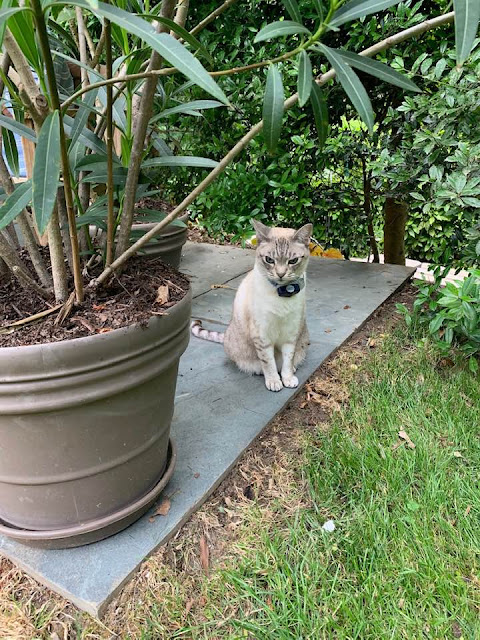I nabbed another photo of the tortoise-shell feline off her blog at https://rockoakdeer.blogspot.com where she said, "She arrived as a feral about four years ago and we began caring for her. Over time, she has become more friendly, but is still wild enough to remain an outdoor cat."
Saturday, June 29, 2019
Be Gone, Begonias!
I nabbed another photo of the tortoise-shell feline off her blog at https://rockoakdeer.blogspot.com where she said, "She arrived as a feral about four years ago and we began caring for her. Over time, she has become more friendly, but is still wild enough to remain an outdoor cat."
Saturday, June 22, 2019
Why Do Cats Go Nuts Over Weigela?
My garden writer friend, Larry Hodgson, over at the Laidback Gardener blog (https://laidbackgardener.blog/) posted this q-and-a on a topic I had never heard of before -- some cats love weigela. I grow many kinds of weigela shrubs in my garden and have not seen any of my cats or other cats interacting with it, but I am going to keep an eye out for it now.
Here is Larry's blog post about it:
Question: My 7-year-old cat has discovered my weigela bush. During
flowering, he climbs into the shrub to grab the flowers, rolls around in it and
meows happily. Honestly, he seems to be high! I have many other plants, but he
leaves them alone. It’s really very funny. Do you know why this happens? ~ H. Filteau
Answer: You’ve hit upon a
situation that is fairly well known to cat-lovers, but one that has not yet, to
my knowledge, been studied. Some cats (a small minority) do indeed seem to
adore weigelas, but others are completely indifferent to these shrubs.
I think
it’s safe to presume that weigelas (or at least some weigelas) give off a
chemical compound of the same type as nepetalactone, the terpene that makes
catnip (Nepeta
cataria)
so attractive to many kitties. Other nepetas (Nepeta spp.) also give off this product, but to a lesser degree.
In fact, protecting ornamental nepetas against overenthusiastic kitties was the
subject of a recent blog: Protecting Nepetas From Cats.
A Repellent With a Feline Side
Effect
If the catnip
produces nepetalactone, it’s as a protection from predatory insects.
Nepetalactone is a recognized insect repellent and few six-legged pests will
attack catnip plants. Its side effect, that is, attracting cats, is less
desirable … for the plant at least. But cat owners have a lot of fun watching
their tabbies interact with dried catnip leaves, often added to cat toys.
Similarly,
some cats avidly rub up against and roll around in honeysuckles (Lonicera spp), including
Tatarian honeysuckle (L.
tataricum),
and it also produces nepetalactone. In fact, honeysuckle shavings too are
sometimes added to cat toys.
Kiwis (Actinidia spp.) produce a
different product that attracts and intoxicates cats in the same way:
actinidine. The silver vine kiwi or matatabi (A. polygama) is particularly rich in actinidine. In fact, in the Orient,
silver vine sticks are more often used in cat toys than catnip.
REPORT THIS AD
In my own
garden, a brown and white cat often rubs against and scratches my female arctic
kiwi (A.
kolomikta),
obviously in ecstasy. Oddly, she never touches the male vine. Maybe my female
cultivar, ‘Ananasnaya’, is richer in actinidine than the male? Curiously, other
cats in the neighborhood seem indifferent to both.
Valerian
(Valeriana officinalis), an ornamental
perennial, medicinal plant and, in many areas, noxious weed, also produces
actinidine and will also attract cats.
Finally, cat
thyme (Teucrium
marum)
produces another component that makes cats go a bit nuts: dolicholactone,
chemically very close to nepetalactone. It’s occasionally grown as a cat plant.
How cats respond to these various products differs from one
individual to another. Some only react to nepetalactone, others only to
actinidine and others only to dolicholactone, others to two or all three and
finally, some cats simply don’t gain any euphoric effect from plants of any
kind. Also, the reaction can also vary depending on the conditions: for
example, some female cats don’t react to these products during pregnancy, but
resume once their kittens are born.
Now
what we need is a scientific study of exactly what compound in weigelas attract
cats… and then I’ll have an appropriate answer to your question!Friday, June 14, 2019
Hachi: A Cat's Tale
 |
| Hachi reacts with consternation to my meowing at him. |
She writes, "His name is Hachi. He is an Ocicat breed. He is extremely loving and friendly to others but an avid hunter. Keeps after the chipmunks and has rid the garden of moles, voles, and mice. When he isn’t busy hunting, he loves to ride around with me in the car on errands.
The little box on his collar keeps him as a house and garden cat. Otherwise, he would be over the fence- hunted and eaten by the many, many foxes in the neighborhood."
 |
| Why are all these insane plant people in my garden? |
 |
| Pet me, please! |
 |
| Those gorgeous hunter eyes, |
 |
| Hachi accepts stranger's kisses. |
 |
| Guarding his corner of the garden. |
 |
| A sign from Inez's kitchen. |
Subscribe to:
Comments (Atom)


